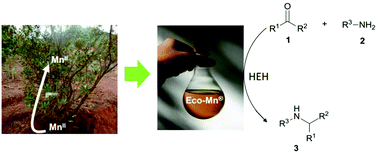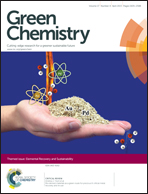Phytoextracted mining wastes for ecocatalysis: Eco-Mn®, an efficient and eco-friendly plant-based catalyst for reductive amination of ketones†
Abstract
The rehabilitation of contaminated soils from phytoextraction technologies and the chemical recovery of subsequent biomass constitute a new strategy for recycling of vital minerals required by industrial chemistry. Plant wastes derived from phytoextraction constituted the raw material for the preparation of eco-friendly catalysts for organic synthesis, namely Ecocatalysis. Eco-Mn® was thus prepared starting from native plants used for rehabilitation of New Caledonian mining sites. Eco-Mn® revealed an original polymetallic composition resulting in marked Brønsted and Lewis acidities and displayed superior catalytic performances to classical Mn salts, as highlighted by the infrared study of pyridine desorption and model test reactions. The performance of Eco-Mn® was illustrated by the reductive amination of ketones, under solvent-free conditions, with the easily prepared and safe Hantzsch ester (HEH) as the reducing agent. A beneficial influence of water was observed with a model MnCl2-catalyzed reaction. Investigation of this effect revealed that water was specifically involved in the second step of the reaction, by activating both the imine substrate and the reducing agent. Finally, the Eco-Mn®/HEH methodology was applied to the reductive amination of various ketones and amines, giving good yields of products (up to 99%), including two precursors of pharmaceutical compounds.

- This article is part of the themed collection: Elemental Recovery and Sustainability

 Please wait while we load your content...
Please wait while we load your content...